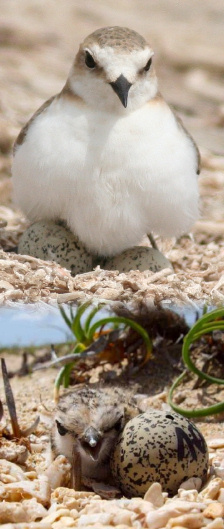A CAGARRA
Boletim de Sociedade Caboverdiana de Zoologia
continuation of | continuação das ZOOLOGICAL NEWS | NOTÍCIAS ZOOLÓGICAS
Edited by | Editado por Cornelis J. Hazevoet cjhazevoet at gmail.com
No. 5 - MARCH / MARÇO DE 2014

Have you seen, heard or read something of zoological interest? Let us know!
Viu, leu ou ouviu algo com interesse zoológico recentemente? Informe-nos!
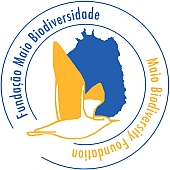
Community-based conservation – a key to successful sea turtle protection in the island of Maio, Cape Verde Islands
In 2013, the Fundação Maio Biodiversidade (FMB) trialled a new sea turtle conservation strategy on Maio. The island is one of the three most important nesting sites for the endangered loggerhead sea turtle Caretta caretta in the Cape Verde Islands and had the highest rates of killed females and poached nests in the country in 2012. As a result of FMB’s work, just in one season the total number of killed nesting turtles on the protected beaches was reduced from 152 in 2012 to 38 in 2013 as compared to the same area and only 2% of the nests were poached on the protected beaches.
One of the main strengths of the strategy was that turtle conservation teams were based in eight of the coastal communities around the island. The teams were made up of a minimum of two guards from the communities, a team leader from Maio or another island and national and international volunteers. The team members were hosted by local families. The integration of the teams in the communities made the efforts to protect sea turtles more visible in coastal villages, while men, women and especially the youth had opportunities to observe and participate in night patrols, nesting beach clean-ups and awareness raising events. The activities opened the door to the turtle world, showing the threats these animals are facing, especially during the highly vulnerable nesting period. In addition, host families received financial benefits for their hospitality. It seems that the combination of both practical education and turtle friendly income opportunities were key to the success of FMB’s strategy.
Human predation is considered to be one of the major threats for sea turtles in Maio. In contrast to the islands of Sal and Boa Vista, the island has not yet been influenced by mass tourism. There still remain beaches not covered by the protection teams, where turtles and nests are still taken frequently. It is very important to expand the project to include the remaining villages of Maio, for which additional funding is urgently needed.
Fundação Maio Biodiversidade, Vila do Maio, Janeiro de 2014.
Monitoring Kentish plover populations in Maio, Cape Verde Islands
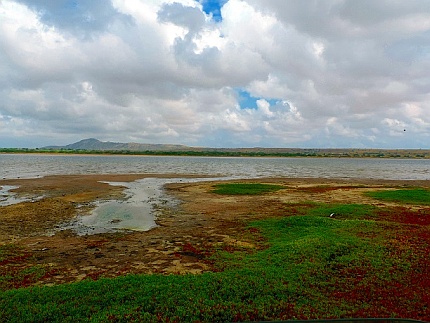
Salinas do Porto Inglês, Maio, Cape Verde Islands.
© Cristina Carmona.
From September to December 2013, the Fundação Maio Biodiversidade (FMB) - together with the Biodiversity lab of the University of Bath, U.K. - undertook the yearly activities of monitoring and ringing the plover population during the breeding season. We searched for nests in the area, ringed all unringed adult breeders and waited for the chicks to hatch to ring them. In addition, weekly surveys of the plover population were carried out this year for the first time. Surveys involved two main objectives: 1) recording individuals’ sex, colour rings and their location, and 2) recording the presence of external agents that could potentially endanger breeding birds and/or the protected area of the Salinas (e.g. large numbers of tourists, cattle, ravens, cars).
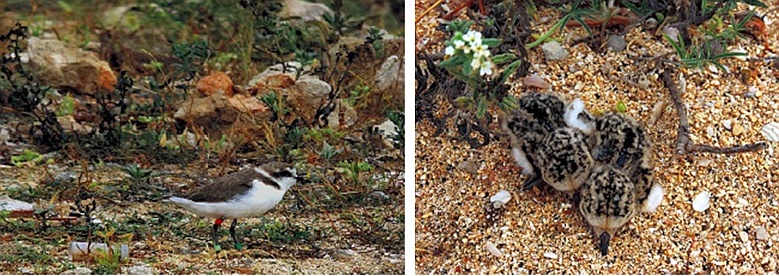
© Cristina Carmona.
In 2013, we found a total of 104 plover nests, of which 36% hatched and 51% disappeared. We followed 62 plover broods, of which 22 reached the fledging age (representing 34% of all broods). Therefore, a high proportion of nests and chicks were lost or presumably predated.
Monitoring of the plover population at the Salinas do Porto Inglês is important for three reasons. First, by estimating the number of individuals we can obtain a yearly assessment of population changes. Second, evaluating nest success reveals threats and can lead to conservation actions. For instance, brown-necked ravens Corvus ruficollis have become more common in recent years. The increase of ravens in the area coincides with the establishment of the Salina Beach Resort in 2010, which in turn coincides with the increase in predation percentage observed in Kentish plover nests and chicks. Ravens pose a threat not only to plovers, but to all the breeding birds in the area. Third, monitoring nests and broods has revealed that plover families use a large area around the Salinas. Therefore, building houses and vilas in close proximity to the Salinas will most likely endanger nests and plover families.
Periodic surveys at the Salinas allowed us to identify an additional potential risk in the cruise tourism. Cruise tourism to Maio will increase in the near future and, given the proximity of the Salinas to Maio’s pier, the access to the Salinas during the breeding season should be restricted, along with the building of a fence to avoid disturbance of nesting birds.
We anticipate that the plover monitoring project run jointly by FMB and the University of Bath will continue in future years. We are always looking for volunteers to help with our work. Please contact us at office@maioconservation.org if you’d like to get involved.
We would like to thank the Direcção Geral do Ambiente (DGA) and the Câmara Municipal do Maio (CMM) for their support and permission to work at the Salinas do Porto Inglês and all staff and friends of FMB for their support.
Cristina Carmona, Alex Tavares, Franziska Koenen, Edihno Innes and Tamás Székely, Department of Biology & Biochemistry, University of Bath, and Fundação Maio Biodiversidade.
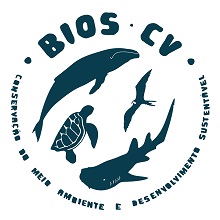 On
the morning of 24 February 2014, the carcass of a dolphin was found at
Praia Cabral, north of Sal Rei, Boa Vista, Cape Verde Islands. Before
being burried, a few photographs of the dolphin were taken, which
allowed the animal to be positively identified as Fraser’s dolphin Lagenodelphis hosei.
Total length was reported to be 2.24 m. After the place of burial had
been pointed out to BIOS-CV collaborator Pedro López-Suárez, skin
samples were taken and preserved in 80% ethanol. Upon checking the
burial site again the next morning, it was found that the carcass had
been butchered during the night, with the flesh presumably being taken
to be sold locally. Nevertheless, the animal’s head could still be
saved and this was burried elsewhere, with the skull to be retrieved at
a later date and subsequently deposited in the Boa Vista reference
collection, maintained jointly by BIOS-CV and Cabo Verde Natura 2000.
On
the morning of 24 February 2014, the carcass of a dolphin was found at
Praia Cabral, north of Sal Rei, Boa Vista, Cape Verde Islands. Before
being burried, a few photographs of the dolphin were taken, which
allowed the animal to be positively identified as Fraser’s dolphin Lagenodelphis hosei.
Total length was reported to be 2.24 m. After the place of burial had
been pointed out to BIOS-CV collaborator Pedro López-Suárez, skin
samples were taken and preserved in 80% ethanol. Upon checking the
burial site again the next morning, it was found that the carcass had
been butchered during the night, with the flesh presumably being taken
to be sold locally. Nevertheless, the animal’s head could still be
saved and this was burried elsewhere, with the skull to be retrieved at
a later date and subsequently deposited in the Boa Vista reference
collection, maintained jointly by BIOS-CV and Cabo Verde Natura 2000.
Fraser’s dolphin Lagenodelphis hosei, Praia Cabral, Boa Vista, Cape Verde Islands, 24 February 2014.
© Gennaro Cascella.
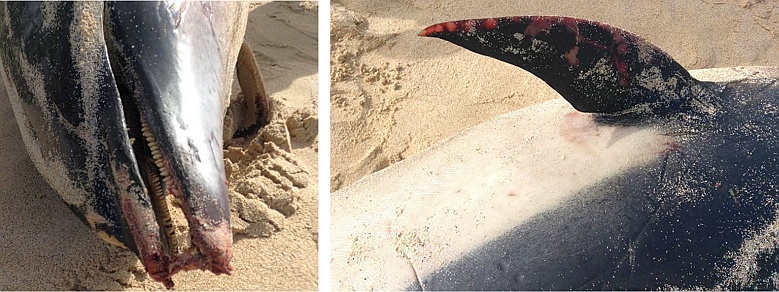
© Gennaro Cascella.
This constitutes only the third record of Fraser’s dolphin for the Cape Verde archipelago. Previous records were of a pod of ca. 20 animals, 5 nm southwest of São Nicolau, 31 August 2003, and a beached animal at Curral Velho, southern Boa Vista, 10 March 2006 (Torda et al., Zoologia Caboverdiana 1: 71-73, 2010). The status of Fraser’s dolphin in the eastern tropical Atlantic (ETA), defined as the waters extending from Mauritania to Angola along the west coast of Africa, was recently reviewed by Weir et al. (Marine Biodiversity Records 6; e35, 2013), who were able to report altogether 10 confirmed records for the ETA area, to which an 11th can now be added.
Pedro López-Suárez (BIOS-CV) and Cornelis J. Hazevoet (SCVZ).
A glimmer of hope for the magnificent frigatebird in Cape Verde
During a visit to Curral Velho islet on 10 January 2014, a frigatebird nest with a single egg was found, but during a subsequent visit on 13 March, only egg shells were found and the egg apparently did not hatch and was presumably predated.
At present, Curral Velho islet is the only breeding locality of Fregata in the Cape Verde archipelago and, indeed, in the whole of the eastern Atlantic. There has been no nesting activity at the former breeding locality of Baluarte islet, off eastern Boa Vista, during the past 10 years. It is as yet unclear if individual frigatebirds from the Cape Verde population engage in long wandering journeys in the Atlantic, only to return to the islands at a later date, or if trans-Atlantic dispersal occurs, with birds from Caribbean populations reaching Cape Verde at times. Investigations into these possibilities are currently underway.
As the white underparts of the two female frigatebirds seen in Boa Vista in February 2014 each showed a slightly different pattern, careful observation may make it possible to distinguish between the two individuals and hence follow their movements more closely. Observers are urged to report all observations of frigatebirds from anywhere in the archipelago, indicating the sex of birds seen, as well as the precise locality, date and any other relevant details.
Pedro López-Suárez (BIOS-CV) and Cornelis J. Hazevoet (SCVZ).
First evidence for humpback whale movement between the Cape Verde Islands and the West Indies
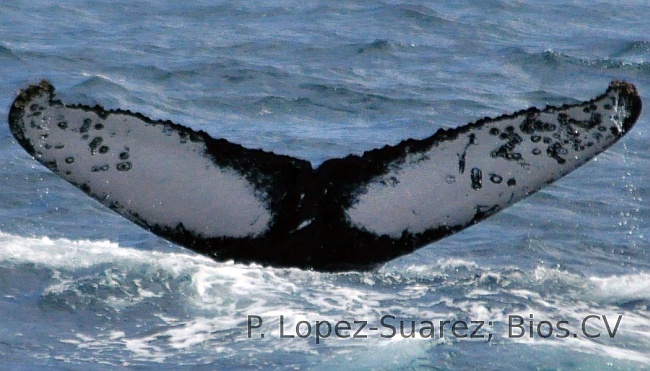
Humpback whale 4756 photographed in the Cape Verde Islands in 2013 by Pedro López-Suárez, BIOS.CV
There are two known wintering grounds for humpback whales Megaptera novaeangliae in the North Atlantic, separated by around 4,000 km of open ocean. For the first time, a whale has been seen moving from one of these North Atlantic winter grounds to the other - and back. Whale number 4756, first seen in the Cape Verde Islands in 2009 and again in 2011, was photographed in the French West Indies in 2012 before returning to the Cape Verde Islands again in 2013. The discovery of this unusual long-distance movement between these discrete breeding areas was the result of a large-scale international collaboration involving BIOS.CV and the Irish Whale and Dolphin Group working in the Cape Verde Islands and BREACH and the National Marine Mammal Lab of NOAA in the French West Indies. The re-sighting was made by researchers from the North Atlantic Humpback Whale Catalogue http://www.coa.edu/nahwc.htm, a central database for identification photographs from across the ocean basin.
Peter Stevick, Humpback Whale Catalogue, College of the Atlantic, Bar Harbor, Maine, USA
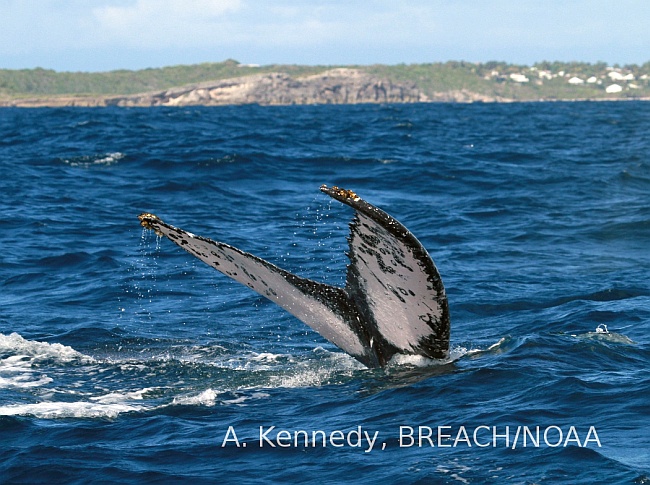
Humpback whale 4756 photographed in the French West Indies in 2012 by Amy Kennedy, BREACH/NOAA.
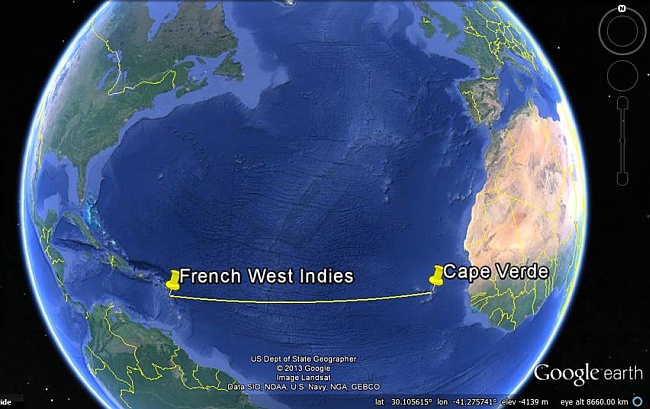
However, nothing is known about the path the whale followed, and the line is not intended to show the track.
Recent papers on Cape Verde zoology and paleontology
Artigos recentes
sobre zoologia e paleontologia Caboverdiana
Potential
adverse health effects of persistent organic pollutants on sea turtles:
Evidences from a cross-sectional study on Cape Verde loggerhead sea
turtles. M. Camacho, O.P. Luzardo, L.D. Boada, L.F. López-Jurado, M. Medina, M. Zumbado, & J. Orós, 2013. Science of the Total Environment 458-460: 283–289; http://dx.doi.org/10.1016/j.scitotenv.2013.04.043
ABSTRACT The Cape Verde nesting population of loggerhead sea turtles (Caretta caretta)
is the third largest population of this species in the world. For
conservation purposes, it is essential to determine how these reptiles
respond to different types of anthropogenic contaminants. We evaluated
the presence of organochlorine pesticides (OCPs), polychlorinated
biphenyls (PCBs), and polycyclic aromatic hydrocarbons (PAHs) in the
plasma of adult nesting loggerheads from Boa Vista Island, Cape Verde,
and studied the effects of the contaminants on the health status of the
turtles using hematological and biochemical parameters. All turtles had
detectable levels of non-dioxin like PCBs, whereas dioxin-like
congeners (DL-PCBs) were detected in only 30% of the turtles. Packed
cell volume decreased with higher concentrations of PCBs, which
suggests that PCB exposure could result in anemia in sea turtles. In
addition, a negative association between some OCPs and white blood
cells (WBC) and thrombocyte estimate was noted. The DDT-metabolite,
p,p′-DDE was negatively correlated with the Na/K ratio and,
additionally, a number of correlations between certain PAHs and
electrolyte balances were found, which suggest that exposure to these
environmental contaminants could affect the kidneys and salt glands in
sea turtles. Additionally, several correlations were observed between
these environmental pollutants (OCPs and PAHs) and enzyme activity
(GGT, ALT, ALP and amylase) and serum protein levels, pointing to the
possibility that these contaminants could induce adverse metabolic
effects in sea turtles. Our results indicate that anthropogenic
pollutants are present in the Cape Verde loggerhead turtle nesting
population and could exert negative effects on several health
parameters. Because of the importance of this loggerhead nesting
population, protective regulations at national and international levels
as well as international action are necessary for assuring the
conservation of this population.
Comparative study of organohalogen contamination between two populations of eastern Atlantic loggerhead sea turtles (Caretta caretta). Maria Camacho, Luís D. Boada, Jorge Orós, Pedro López, Manuel Zumbado, Maria Almeida-González & Octavio P. Luzardo, 2013. Bulletin of Environmental Contamination and Toxicology 91 (6): 678-683; http://dx.doi.org/10.1007/s00128-013-1123-3
ABSTRACT We evaluated the presence of 37 organohalogen contaminants in
plasma samples from 162 juvenile and 197 adult loggerhead turtles (Caretta caretta)
from the archipelagos of the Canary Islands and Cape Verde,
respectively, and compared the contamination profiles found. We
detected five organochlorine pesticides (OCP) and 16 polychlorinated
biphenyls (PCBs). The concentrations of the two groups of contaminants
were higher in turtles from the Canary Islands (OCPs, 1.04 vs. 0.37
ng/mL; PCBs, 1.92 vs. 0.08 ng/mL). We also observed a different profile
of PCB contamination between the two populations. In addition, there
was a negative correlation between body size and the total
concentration of PCBs in the Canary Islands turtles, but not in turtles
from Cape Verde. The present study presents the first data on the
organochlorine contaminants (OCs) of live turtles from Canary Islands.
In addition, we perform a comparison of the levels and profiles of OCs
between these two different groups of loggerhead sea turtles from the
Eastern Atlantic.
Monitoring organic and inorganic pollutants in juvenile live sea
turtles: Results from a study of Chelonia mydas and Eretmochelys
imbricata in Cape Verde. María Camacho, Luis D. Boada, Jorge Orós,
Pedro López, Manuel Zumbado, Maira Almeida-González & Octavio P.
Luzardo, 2014. Science of the Total Environment 481: 303-310; http://dx.doi.org/10.1016/j.scitotenv.2014.02.051
ABSTRACT Despite the current environmental concern regarding the
risk posed by contamination in marine ecosystems, the concentrations of
pollutants in sea turtles have not been thoroughly elucidated. In the
current study, we determined the concentrations of 18 organochlorine
pesticides (OCPs), 18 polychlorinated biphenyls (PCBs), 16 polycyclic
aromatic hydrocarbons (PAHs) and 11 inorganic elements (Cu, Mn, Pb, Zn,
Cd, Ni, Cr, As, Al, Hg and Se) for the first time in two sea turtle
species (Chelonia mydas and Eretmochelys imbricata). Only five of the
18 analyzed OCPs were detected in both species. The average total OCP
concentration was higher in green turtles than in hawksbills (0.33
ng/ml versus 0.20 ng/ml). Higher concentrations of individual congeners
and total PCBs were also detected in green turtles than in hawksbills
(ΣPCBs=0.73 ng/ml versus 0.19 ng/ml), and different PCB contamination
profiles were observed in these two species. Concerning PAHs, we also
observed a different contamination profile and higher levels of
contamination in green turtles (ΣPAHs = 12.06 ng/ml versus 2.95 ng/ml).
Di- and tri-cyclic PAHs were predominant in both populations,
suggesting a petrogenic origin, rather than urban sources of PAHs.
Additionally, all of the samples exhibited detectable levels of the 11
inorganic elements. In this case, we also observed relevant differences
between both species. Thus, Zn was the most abundant inorganic element
in hawksbills (an essential inorganic element), whereas Ni, a
well-known toxicant, was the most abundant inorganic element in green
turtles. The presence of contaminants is greater in green turtles
relative to hawksbill turtles, suggesting a greater exposure to
hazardous chemical contaminants for green turtles. These results
provide baseline data for these species that can serve for future
monitoring purposes outlined in the EU's Marine Strategy Framework
Directive.
Geographic patterns of genetic variation in a broadly distributed
marine vertebrate: new insights into loggerhead turtle stock structure
from expanded mitochondrial DNA sequences. Brian M. Shamblin, Alan B.
Bolten, F. Alberto Abreu-Grobois, Karen A. Bjorndal, Luis Cardona,
Carlos Carreras, Marcel Clusa, Catalina Monzón-Argüello, Campbell J.
Nairn, Janne T. Nielsen, Ronel Nel, Luciano S. Soares, Kelly R.
Stewart, Sibelle T. Vilaça, Oguz Türkozan, Can Yilmaz, Peter H. Dutton,
2014. PLoS ONE 9(1): e85956.
http://dx.doi.org/10.1371/journal.pone.0085956
ABSTRACT Previous genetic studies have demonstrated that natal
homing shapes the stock structure of marine turtle nesting populations.
However, widespread sharing of common haplotypes based on short
segments of the mitochondrial control region often limits resolution of
the demographic connectivity of populations. Recent studies employing
longer control region sequences to resolve haplotype sharing have
focused on regional assessments of genetic structure and
phylogeography. Here we synthesize available control region sequences
for loggerhead turtles from the Mediterranean Sea, Atlantic, and
western Indian Ocean basins. These data represent six of the nine
globally significant regional management units (RMUs) for the species
and include novel sequence data from Brazil, Cape Verde, South Africa
and Oman. Genetic tests of differentiation among 42 rookeries
represented by short sequences (380 bp haplotypes from 3,486 samples)
and 40 rookeries represented by long sequences (~800 bp haplotypes from
3,434 samples) supported the distinction of the six RMUs analyzed as
well as recognition of at least 18 demographically independent
management units (MUs) with respect to female natal homing. A total of
59 haplotypes were resolved. These haplotypes belonged to two highly
divergent global lineages, with haplogroup I represented primarily by
CC-A1, CC-A4, and CC-A11 variants and haplogroup II represented by
CC-A2 and derived variants. Geographic distribution patterns of
haplogroup II haplotypes and the nested position of CCA11.6 from Oman
among the Atlantic haplotypes invoke recent colonization of the Indian
Ocean from the Atlantic for both global lineages. The haplotypes we
confirmed for western Indian Ocean RMUs allow reinterpretation of
previous mixed stock analysis and further suggest that contemporary
migratory connectivity between the Indian and Atlantic Oceans occurs on
a broader scale than previously hypothesized. This study represents a
valuable model for conducting comprehensive international cooperative
data management and research in marine ecology.
Phylogeny of Parablennius Miranda Ribeiro, 1915 reveals a paraphyletic
genus and recent Indo-Pacific diversification from an Atlantic
ancestor. A. Levy, S. von der Heyden, S.R. Floeter, G. Bernardi, V.C.
Almada, 2013. Molecular Phylogenetics and Evolution 67 (1): 1-8;
http://dx.doi.org/10.1016/j.ympev.2012.12.010
ABSTRACT A molecular phylogeny of 15 (out of 26 recognized) species of
Parablennius Miranda Ribeiro, 1915 was constructed based on two
mitochondrial and two nuclear gene fragments, and using maximum
parsimony, maximum likelihood and Bayesian approaches. The closely
related genera Hypleurochilus, and Salaria Scartella were also studied
to ascertain their relationship with Parablennius. Phylogenetic
analyses were compared with morphology-based taxonomical studies.
Hypleurochilus, Salaria and Scartella appear well supported within a
clade including all Parablennius, indicating that this genus is
paraphyletic. The species pairs P. parvicornis–P. sanguinolentus and P.
gattorugine–P. ruber are well-supported and relatively distant from
remaining Parablennius. Remaining Parablennius form two distinct
well-supported groups: (1) a clade of Atlantic-Mediterranean
Parablennius (P. pilicornis, P. marmoreus, P. rouxi, P. salensis and P.
tentacularis); (2) a clade including Hypleurochilus, the Indo-Western
Pacific Parablennius (P. cornutus, P. intermedius, P. tasmanianus and
P. yatabei) and the Atlantic-Mediterranean P. incognitus and P.
zvonimiri. Use of a relaxed molecular clock suggests that Indo-Pacific
Parablennius originated recently from an Atlantic Parablennius that may
have dispersed via southern Africa, rather than via the Tethys seaway.
[SCVZ Editor’s note: Although not mentioned in the abstract, the
analysis includes Parablennius salensis and Scartella caboverdiana from
the Cape Verde Islands.]
Weight–length relationships for 27 demersal fish species caught off the
Cape Verde archipelago (eastern North Atlantic). J.N. Pereira, A.
Simas, A. Rosa, A. Aranha, S. Lino, E. Constantino, V. Monteiro, O.
Tariche & G. Menezes, 2012. Journal of Applied Ichthyology 28 (1):
156-159;
http://dx.doi.org/10.1111/j.1439-0426.2011.01915.x
ABSTRACT Weight–length relationships were estimated for 27
demersal fish species of the Cape Verde archipelago. Samples were
collected in October and November 2000 using longline gear in depths up to 600 m, and occasionally to 1200 m. The b values were
within expected ranges, varying between 2.406 and 3.761, except for
Syacium micrurum (1.574) and Paraconger notialis (4.476), which
presented strong allometries instigated through further analysis. This
work revises previous literature in the archipelago and provides the
first reference on weight–length parameters for 10 fish species
worldwide and for 21 species of the Cape Verde archipelago.
A new species of the genus Anthrenus Geoffroy, 1762 (Coleoptera:
Dermestidae: Megatominae) from the Republic of Cape Verde. Andreas
Herrmann & Jiří Háva, 2012. Studies and Reports (Prague),
Taxonomical Series, 8 (1-2): 127-130.
ABSTRACT Anthrenus (Nathrenus) strakai sp. nov. from the Republic of
Cape Verde is described, illustrated and compared with the similar
looking species Anthrenus (Nathrenus) molitor Aubé, 1850 and Anthrenus
(Nathrenus) signatus Erichson, 1846, both from the Mediterranean region.
Insecticide susceptibility of Aedes aegypti populations from Senegal
and Cape Verde archipelago. Ibrahima Dia, Cheikh Tidiane Diagne, Yamar
Ba, Diawo Diallo, Lassana Konate & Mawlouth Diallo, 2012. Parasites
& Vectors 5:238 (4 pages); http://dx.doi.org/10.1186/1756-3305-5-238
ABSTRACT Two concomitant dengue 3 (DEN-3) epidemics occurred in
Cape Verde Archipelago and Senegal between September and October 2009.
Aedes aegypti was identified as the vector of these epidemics as
several DEN-3 virus strains were isolated from this species in both
countries. The susceptibility to pyrethroids, organochlorine,
organophosphates and carbamate was investigated in two field strains of
A. aegypti from both countries using WHO diagnostic bioassay kits in
order to monitor their the current status of insecticide
susceptibility. The two tested strains were highly resistant to DDT.
The Cape Verde strain was found to be susceptible to all others tested
insecticides except for propoxur 0.1%, which needs further
investigation. The Dakar strain was susceptible to fenitrothion 1% and
permethrin 0.75%, but displayed reduced susceptibility to deltamethrin,
lambda-cyhalothrin and propoxur. As baseline results, our observations
stress a careful management of insecticide use for the control of A.
aegypti. Indeed, they indicate that DDT is no longer efficient for the
control of A. aegypti populations in Cape Verde and Dakar and further
suggest a thorough follow-up of propoxur susceptibility status in both
sites and that of deltamethrin and lambda-cyhalothrin in A. aegypti
populations in Dakar. Thus, regular monitoring of susceptibility is
greatly needed as well as the knowing if this observed
resistance/susceptibility is focal or not and for observed resistance,
the use of biochemical methods is needed with detailed comparison of
resistance levels over a large geographic area.
Littoral Tanaidacea (Crustacea: Peracarida) from Macaronesia: allopatry
and provenance in recent habitats. Roger N. Bamber, 2012. Journal of
the Marine Biological Association of the United Kingdom 92(5):
1095-1116. http://dx.doi.org/10.1017/S0025315412000252
ABSTRACT The Macaronesian Islands in the mid-Atlantic pose a number of
questions relating to their colonization by littoral tanaidaceans, as
these taxa have no obligate dispersive phase. Recent surveys of the
four main archipelagos discovered twelve species of tanaidacean, four
of which are new to science, in seven genera (one new to science). In
addition, some taxa described by Vanhöffen at the beginning of the last
century were rediscovered. All the taxa are described, and their
zoogeography, likely origin, and possible means of colonization are
discussed.
[SCVZ Editor’s note: Includes descriptions of Gamboa darwini sp. nov.
and Parapseudes fitzroyi sp. nov., type locality, Ilhéu Santa Maria
(Quail Islet), Praia, Santiago, Cape Verde Islands, and Zeuxo
(Parazeuxo) coturnix sp. nov., type locality, Praiamar, Praia,
Santiago, Cape Verde Islands.]
Tanaidacea (Crustacea) from Macaronesia III. The shallow-water
Tanaidomorpha from the Cape Verde archipelago. Kim Larsen, Ryoko
Nagaoka & Elsa Froufe, 2012. Zootaxa, 3498: 24-44.
ABSTRACT Three new species of Tanaidacea are described from the Cape
Verde archipelago in the Mid-Atlantic, collected during the sampling
program of the Laboratory of Marine Community Ecology and Evolution
(LMCEE) to Macaronesia and former Portuguese colonies. The new species
belong to the tanaidomorphan families Leptocheliidae (Leptochelia
parasavignyi), Paratanaidae (Paratanais vicentetis), and Pseudotanaidae
(Pseudotanais breviaquas).
Die Pterophoridae der Kapverdischen Inseln, 2. Beitrag, mit der
Beschreibung einer neuen Art der Gattung Stenoptilia Hübner
(Lepidoptera: Pterophoridae). E. Arenberger & E. Aistleitner, 2012.
Nachrichtenblatt der Bayerischen Entomologen 61(1/2): 23-25.
ABSTRACT A list of the Pterophoridae from new collections from
the Caboverde Islands is given. Stenoptilia fogoa sp. nov., type
locality, Bangaeira, Chã das Caldeiras, Fogo, Cape Verde Islands, is
described and its imago and the genitalia of both sexes are illustrated.
Patterns of diversity of the Rissoidae (Mollusca: Gastropoda) in the
Atlantic and the Mediterranean Region. Sérgio P. Ávila, Jeroen Goud
& António M. de Frias Martins, 2012. The Scientific World Journal
2012, Article ID 164890, 30 pp.; http://dx.doi.org/10.1100/2012/164890
ABSTRACT The geographical distribution of the Rissoidae in the Atlantic
Ocean and Mediterranean Sea was compiled and is up-to-date until July
2011. All species were classified according to their mode of larval
development (planktotrophic and nonplanktotrophic), and bathymetrical
zonation (shallow species - those living between the intertidal and 50
m depth, and deep species - those usually living below 50 m depth). 542
species of Rissoidae are presently reported from the Atlantic Ocean and
the Mediterranean Sea, belonging to 33 genera. The Mediterranean is the
most diverse site, followed by Canary Islands, Caribbean, Portugal, and
Cape Verde. The Mediterranean and Cape Verde Islands are the sites with
higher numbers of endemic species, with predominance of Alvania spp. in
the first site, and of Alvania and Schwartziella at Cape Verde. In
spite of the large number of rissoids at Madeira archipelago, a large
number of species are shared with Canaries, Selvagens, and the Azores,
thus only about 8% are endemic to the Madeira archipelago. Most of the
542-rissoid species that live in the Atlantic and in the Mediterranean
are shallow water species (323), 110 are considered as deep water
species, and 23 species are reported in both shallow and deep waters.
There is a predominance of non-planktotrophs in islands, seamounts, and
at high and medium latitudes. This pattern is particularly evident in
the genera Crisilla, Manzonia, Onoba, Porosalvania, Schwartziella, and
Setia. Planktotrophic species are more abundant in the eastern Atlantic
and in the Mediterranean Sea. The results of the analysis of the
probable directions of faunal flows support the patterns found by both
the Parsimony Analysis of Endemicity and the geographical distribution.
Four main source areas for rissoids emerge: Mediterranean, Caribbean,
Canaries/Madeira archipelagos, and the Cape Verde archipelago.We must
stress the high percentage of endemics that occurs in the isolated
islands of Saint Helena, Tristan da Cunha, Cape Verde archipelago and
also the Azores, thus reinforcing the legislative protective actions
that the local governments have implemented in these islands during the
recent years.
Two beautiful and new Euthria (Gastropoda: Buccinidae) from the
northern Cape Verde Archipelago. Koen Fraussen, Bernardino Monteiro
& Frank Swinnen, 2012. Gloria Maris 51 (1): 16-24.
ABSTRACT Two beautiful species collected in the northern part of the
Cape Verde Archipelago are described as new. Euthria placibilis sp.
nov. is compared with E. soniae Rolán, Monteiro & Fraussen, 2003
and E. ponsonbyi Sowerby, 1889; Euthria inesae sp. nov. is compared
with E. josepedroi Rolán & Monteiro, 2007 and E. cecilea Fraussen
& Rolán, 2003.
The genus Gibberula (Gastropoda, Cystiscidae) in the Cape Verde Islands
with the description of a new species. Diego Moreno, 2012. Iberus,
30(1): 67-83.
ABSTRACT The species of the genus Gibberula from the Cape Verde
islands are reviewed. There are at least four species, three previously
described: Gibberula lucia Jousseaume, 1877, G. rauli Fernandes, 1987
and G. rolani Cossignani and Cecalupo, 2005, and one new species, G.
elvirae n. sp. is here described. Gibberula rachmaninovi Kellner, 2003,
is considered here as a synonym of Volvarina sauliae (Sowerby, 1846).
A new species of Phorcus (Vetigastropoda, Trochidae) from the Cape
Verde Islands. José Templado & Emilio Rolán, 2012. Iberus 30 (2):
89-96.
ABSTRACT A recent molecular study has shown that the well-known
intertidal Cape Verde topshell, previously identified as Osilinus
punctulatus, O. tamsi or O. atratus, is a distinct undescribed species
(Donald et al. 2012). Therefore we describe it here as new for science
and compare it to the closest species.
[SCVZ Editor’s note: Description of Phorcus mariae sp. nov., type locality, Sal Rei, Boa Vista, Cape Verde Islands.]
A new subspecies of Haliotis tuberculata Linnaeus, 1758 from the Cape
Verde Islands, Central West Africa. Buzz Owen & Carlos M.L. Afonso,
2012. Pp. 56-60 in Daniel L. Geiger & Buzz Owen (eds.), Abalone:
World-wide Haliotidae. viii + 361 pp., 99 figs., 92 col. pls.,
hardcover, ConchBooks, Hackenheim, Germany.
[SCVZ Editor’s note: Description of Haliotis tuberculata fernandesi
ssp. nov., type locality, Ponta Norte, Sal Island, Cape Verde Islands.]
At the bottom of the deep blue sea: a new wood-boring bivalve
(Mollusca, Pholadidae, Xylophaga) from the Cape Verde Abyssal Plain
(subtropical Atlantic). Janet R. Voight & Michel Segonzac, 2012.
Zoosystema 34 (1):171-180; http://dx.doi.org/10.5252/z2012n1a8
ABSTRACT Bivalves of Xylophaga Turton, 1822 require access to wood or
other vegetation on the seafloor, into which they bore. They ingest the
wood and, with the aid of bacteria, digest it to survive. Their
complete dependence on vegetation for survival suggests that the group
would be rare on the abyssal plains, as the availability of terrestrial
vegetation declines with distance from land masses. Deployment of a
small block of wood on a mooring at 4626 m depth in the Cape Verde
Abyssal Plain, over 1600 km west of Africa tested that suggestion. When
recovered seven months after deployment, the wood carried an estimated
170 boreholes/cm2 evidence of extremely and surprisingly rapid
colonization by a previously unknown species, here described as
Xylophaga alexisi n. sp. The species is unique in having an incomplete
siphon, a posterior adductor scar made of linear elements and in
lacking cirri at both siphonal openings. Atlantic species described by
Harvey (1996) are compared to this and other species. The bivalves are
estimated to have grown 0.011 mm per day, comparable to growth
estimates of X. ricei Harvey, 1996 at 5000 m depth. The high density of
this species at this site, the great distance of the site from the
continent which is so arid to be Saharan in character and the minimal
input the site receives from surface and bottom currents argue strongly
that wood-boring species thrive in the largest benthic habitat on
Earth, the abyssal plain.
Revision of the genera Murchisonella and Pseudoaclisina (Gastropoda,
Heterobranchia, Murchisonellidae). Anselmo Peñas & Emilio Rolán,
2013. Vita Malacologica 11: 15-64.
ABSTRACT A revision of the species of two genera of the family
Murchisonellidae Casey, 1904, which have Recent representatives
Murchisonella Casey, 1904 and Pseudoaclisina Yoo, 1994, is presented.
All the known species are figured, their morphologies described and
comparisons made. In the first genus, Murchisonella, 22 species are
recognised, from which 10 are new; in the other genus, Pseudoaclisina,
there are seven, which all are new species for science.
[SCVZ Editor’s note: Includes description of Murchisonella africana sp.
nov., type locality, Tarrafal, Santiago, Cape Verde Islands.]
Extreme habitat adaptation by boring bivalves on volcanically active
paleoshores from North Atlantic Macaronesia. Ana Santos, Eduardo
Mayoral, Markes E. Johnson, B. Gudveig Baarli, Mário Cachão, Carlos
Marques Silva & Jorge Ledesma-Vázquez, 2012. Facies 58:
325-338;
http://dx.doi.org/10.1007/s10347-011-0283-z
ABSTRACT Extensive bivalve borings are described in detail for the
first time from basalt rockgrounds in the North Atlantic volcanic
islands of Macaronesia. They occur on a Middle Miocene rocky shore of a
small islet of Porto Santo (Madeira Archipelago of Portugal), as well
as on Plio-Pleistocene rocky shores on Santiago Island (Cape Verde). A
basalt substrate is widely penetrated by clavate-shaped borings
belonging to the ichnogenus Gastrochaenolites interpreted as dwelling
structures of suspension-feeding bivalves. Some of these borings still
retain evidence of the alleged trace-makers preserved as body fossils,
while others are filled with their casts. The ichnofossil assemblage
present on these bioeroded surfaces belongs to the Entobia ichnofacies.
Recognition of Gastrochaenolites borings in volcanic rocks provides
useful paleoenvironmental information regarding an expanded strategy
for hard-substrate colonization. Preliminary results from fieldwork in
the Cape Verde Archipelago indicate that such borings are more
widespread through Macaronesia than previously thought.
A new species of Spauligodon (Nematoda: Oxyurida: Pharyngodonidae) in
geckos from São Nicolau Island (Cape Verde) and its phylogenetic
assessment. Fátima Jorge, Miguel A. Carretero, Ana Perera, D. James
Harris & Vicente Roca, 2012. Journal of Parasitology 98 (1):
160-166;
http://dx.doi.org/10.1645/GE-2856.1
ABSTRACT A new nematode species, Spauligodon nicolauensis n. sp., is
described from geckos Tarentola bocagei and Tarentola nicolauensis on
the island of São Nicolau, Cape Verde. The new nematode was found in
the pellets obtained directly from the geckos in a non-invasive
fashion, and its identity was assessed both at morphologic and genetic
levels. The new species has morphological similarities with Spauligodon
tarentolae Spaul, 1926, also parasitizing geckos from the Canary
Islands. However, the male cloacal region in the new species is
distinct, presenting a different shape of the caudal papillae. The
overall resemblance probably resulted from colonization via descent
from an ancestor of S. tarentolae carried by the ancestor of Cape Verde
Tarentola. The analysis of nuclear DNA sequences confirms that the new
species is phylogenetically distinct from all other Spauligodon species
already analyzed, forming a group clearly separated from species
parasitizing lacertid lizards. The COI genetic distance suggests that
the S. nicolauensis n. sp. found in the two species of geckos in São
Nicolau Island may have resulted from a host-switching event, when they
came into contact after the unification of the island.
First report of Dirofilaria immitis in the Republic of Cape Verde.
Cristina Pereira, Conceição Almeida, Manuel Malta, Raquel Vilaça &
Pablo Payo-Puente, 2013. Veterinary Parasitology 192: 290-291.
http://dx.doi.org/10.1016/j.vetpar.2012.09.032
ABSTRACT In Maio Island, Republic of Cape Verde, a seven-year old
mongrel female dog exhibiting severe generalized adenomegaly and a poor
body condition was examined during an animal welfare campaign. A blood
smear was drawn from peripheral blood collection and several organisms
consistent with Dirofilaria immitis microfilariae were identified. Both
the antigen test conducted from plasma and the RT-PCR test performed
from the blood smear sample were positive for D. immitis. This is, to
the best of our knowledge, the first report of D. immitis in Cape
Verde. The fact that the dog was autochthonous and had never left the
island strongly suggests there might be other animals infected with the
parasite. Our finding confirms the existence of the parasite in the
canine population and necessarily implies the presence of a competent
vector. As a serious cardiopulmonary disease and with the risk of the
pathogen spreading rapidly, broader epidemiological studies need to be
conducted to determine D. immitis prevalence in the canine population
of Maio Island.
Sponges of the family Esperiopsidae (Demospongiae, Poecilosclerida)
from Northwest Africa, with the descriptions of four new species. Rob
W.M. van Soest, Elly J. Beglinger & Nicole J. de Voogd, 2012.
European Journal of Taxonomy 18: 1-21; http://dx.doi.org/10.5852/ejt.2012.18
ABSTRACT Sponges belonging to the genera Amphilectus Vosmaer,
Esperiopsis Carter and Ulosa de Laubenfels of the family Esperiopsidae
were collected during 1986 and 1988 expeditions of the Netherlands
Centre for Biodiversity Naturalis (at that time the National Museum of
Natural History at Leiden and the Zoological Museum of Amsterdam) in
waters off the coasts of Mauritania and the Cape Verde Islands. Four
new species, Amphilectus utriculus sp. nov., Amphilectus
strepsichelifer sp. nov., Esperiopsis cimensis sp. nov., Ulosa
capblancensis sp. nov., and two already known species, Amphilectus cf.
fucorum (Esper) and Ulosa stuposa (Esper) are described and discussed.
Diversity patterns and zoogeography of the Northeast Atlantic and
Mediterranean shallow-water sponge fauna. Joana R. Xavier & Rob W.
M. van Soest, 2012. Hydrobiologia 687: 107–125;
http://dx.doi.org/10.1007/s10750-011-0880-4
ABSTRACT Recognizing and understanding present-day biodiversity and
biogeographical patterns and how these relate to contemporary and past
climate is pivotal to predict the effect of future climate on marine
biodiversity and promote adequate conservation policies. Sponges
constitute an important and dominant component of the marine benthos
and are therefore an excellent model group for such investigations. In
this study, we assessed the diversity patterns and the zoogeographical
affinities of the Northeast Atlantic and Mediterranean shallow-water
demosponge assemblages. Data on the distribution of 745 species
throughout 28 areas was compiled from the literature and used to build
a presence/absence matrix. Diversity patterns were assessed from
estimates of species richness (S) and taxonomic distinctness (AvTD).
The Mediterranean Sea proved to be more diverse both in terms of
species richness and taxonomic distinctness (S = 539, AvTD = 94.74)
than the Northeast Atlantic (S = 480, AvTD = 92.42) and the two regions
together were found to constitute a diversity hotspot harbouring
approximately 11% of the global demosponge diversity. We found an
Atlantic N–S and a Mediterranean NW-SE gradient of increasing taxonomic
distinctness that is strongly correlated to both contemporary (R2 =
0.5667; P\0.01) and historical values (R2 = 0.7287; P\0.01) of sea
surface temperature (SST) at the Last Glacial Maximum (LGM). The
zoogeographical affinities examined through classification (cluster
analysis) and ordination (nonmetric multidimensional scaling, nMDS)
based on the Bray–Curtis similarity index, revealed the presence of
three groups approximately corresponding to the Northern European Seas,
Lusitanian and Mediterranean provinces outlined in the ‘Marine
Ecoregions of the World’ (MEOW) classification system. Geographical
distance and oceanographic circulation were shown to constitute
important factors in shaping the zoogeographical affinities among
areas. The vast majority of the species occurring in the Northeast
Atlantic and the Mediterranean (67 and 57%, respectively) was shown to
have extremely restricted geographical ranges, as single-area or
narrow-range (2–3 areas) endemics, which raises some concerns regarding
their conservation.
